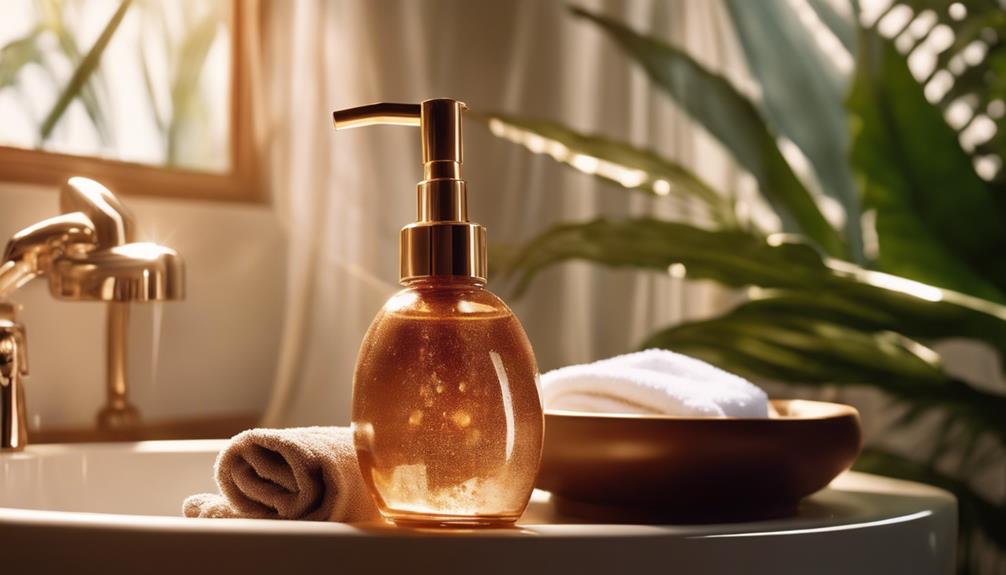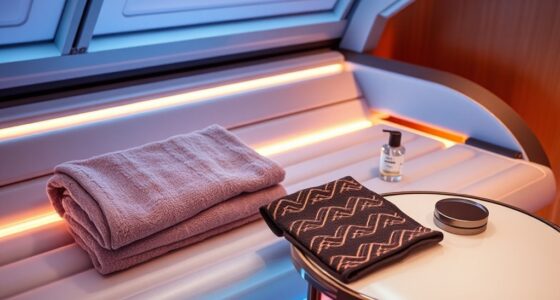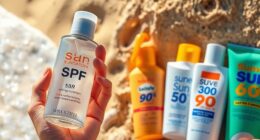Using a tanning bed at home offers the convenience of easy UV exposure, quick skin tanning, and a relaxing self-care routine. However, it also comes with serious health risks like increased chances of skin cancer, premature aging, and eye damage. Safety tips can minimize harm, but legal restrictions for minors and strict regulations exist. For safe alternatives, consider sunless tanning products. Keep exploring to discover more about making informed choices for your skin health.
Key Takeaways
- Home tanning beds offer convenient UV exposure, supporting vitamin D production and skin health.
- They pose health risks like increased melanoma and skin aging with overuse or improper use.
- Safety measures include wearing protective goggles, limiting session times, and maintaining equipment properly.
- Legal restrictions often prohibit minors from using tanning beds, requiring awareness of local laws and regulations.
- Alternatives like sunless tanning products provide UV-free options for achieving a tanned look safely at home.
Advantages of Installing a Tanning Bed at Home
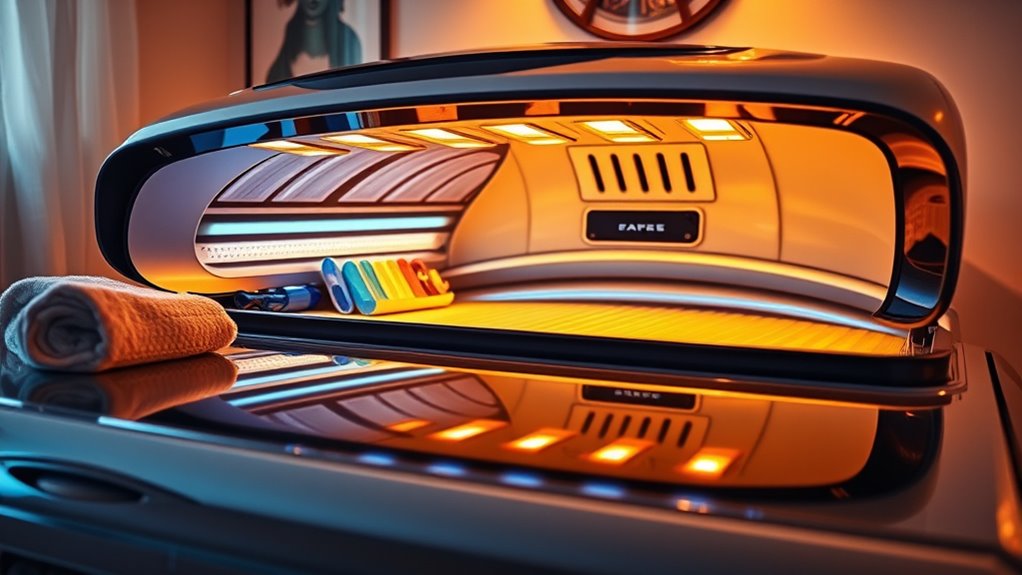
Installing a tanning bed at home offers several compelling advantages that can enhance your overall well-being. First, it provides convenient access to UV exposure, helping you maintain healthy vitamin D levels, especially in areas with limited sunlight. This boost supports bone health, strengthens your immune system, and may lower the risk of certain diseases linked to deficiency. Additionally, tanning beds can improve your mood by stimulating endorphin release and increasing serotonin, which reduces stress and alleviates mild depression. They also promote better skin appearance by giving a natural glow, evening out skin tone, and stimulating collagen production to reduce aging signs. With a home setup, you gain flexibility, control session timing, and create a relaxing environment, seamlessly integrating self-care into your daily routine.
Potential Health Risks and Concerns
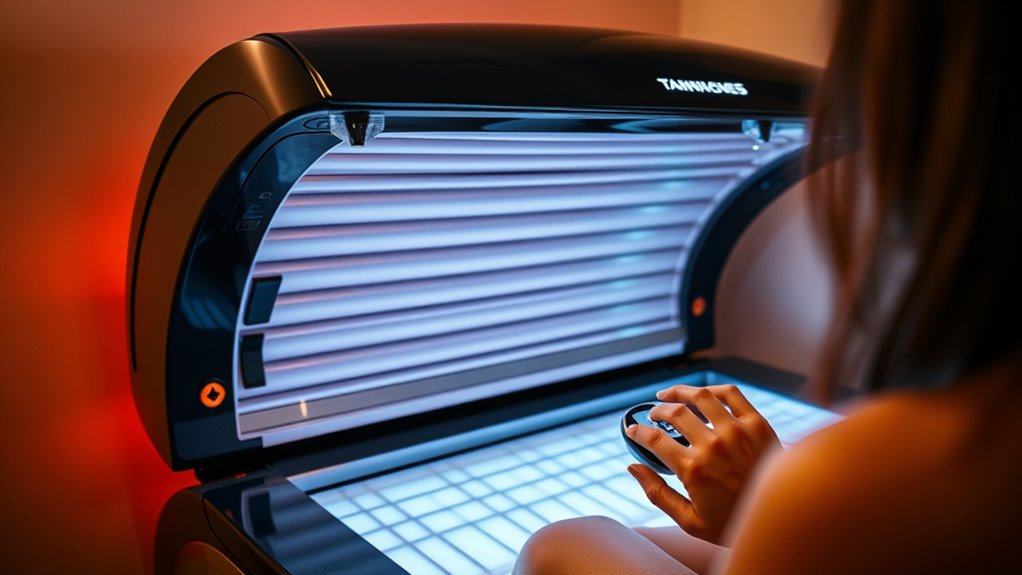
While tanning beds may offer aesthetic benefits, they pose significant health risks that shouldn’t be overlooked. Using them before age 35 increases your melanoma risk by about 75%, and indoor tanning also raises chances of squamous cell carcinoma by 58% and basal cell carcinoma by 24%. Each UV exposure causes DNA damage that accumulates over time, heightening mutation risks linked to cancer. The World Health Organization classifies tanning devices as carcinogenic, comparable to cigarettes and plutonium. Additionally, UVA rays accelerate skin aging, causing wrinkles, loss of elasticity, and uneven pigmentation. Tanning beds can also harm your eyes, leading to severe injuries like cataracts and retinal damage. Many underestimate these risks, believing a “base tan” offers protection, but it’s a myth that can lead to dangerous habits. Genetic predisposition may influence individual vulnerability to skin cancer from UV exposure. Moreover, studies have shown that ultraviolet radiation exposure can impair immune system function, further increasing health risks. It is important to recognize that skin damage from tanning beds is cumulative and irreversible over time. For some individuals, skin pigmentation variations can also affect their susceptibility to UV-induced harm. Additionally, the long-term effects of UV exposure can include increased risk of eye diseases and skin disorders that may develop years later.
Safety Tips for Home Tanning Bed Use
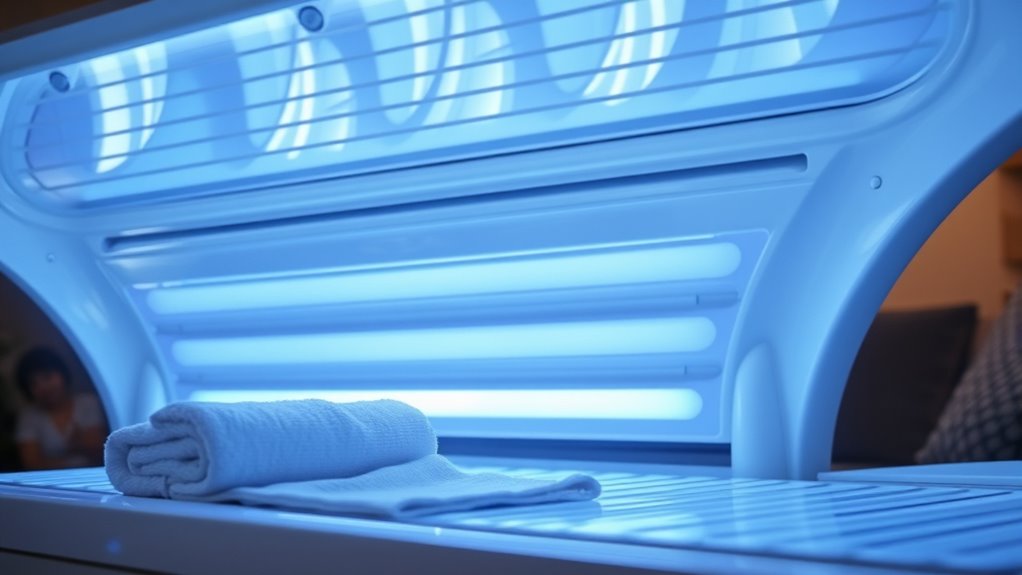
To guarantee safe tanning bed use at home, it’s essential to follow specific precautions that reduce health risks. Always wear fitted goggles designed for tanning beds to protect your eyes from UV damage, as regular sunglasses don’t offer sufficient protection. Limit your sessions to the shortest time recommended by the manufacturer, especially during initial exposures, and avoid tanning more than 2-3 times weekly. Take breaks between sessions to allow your skin to recover. Use only lotions formulated for indoor tanning, and exfoliate skin beforehand for even results. Cover sensitive areas like tattoos or moles to prevent burns. Never use a tanning bed if you’re under 18 or have skin conditions or health issues. Regularly maintain and clean the equipment, and keep children and pets away during use. Being aware of skin health risks and monitoring your skin’s response can help prevent long-term damage. Additionally, staying informed about UV radiation effects can further promote safe tanning practices. Understanding tanning bed safety guidelines can also help users adhere to best practices and prevent adverse effects. Remember that digital literacy programs can also help users understand safe practices and recognize early signs of skin damage.
Regulatory and Legal Considerations
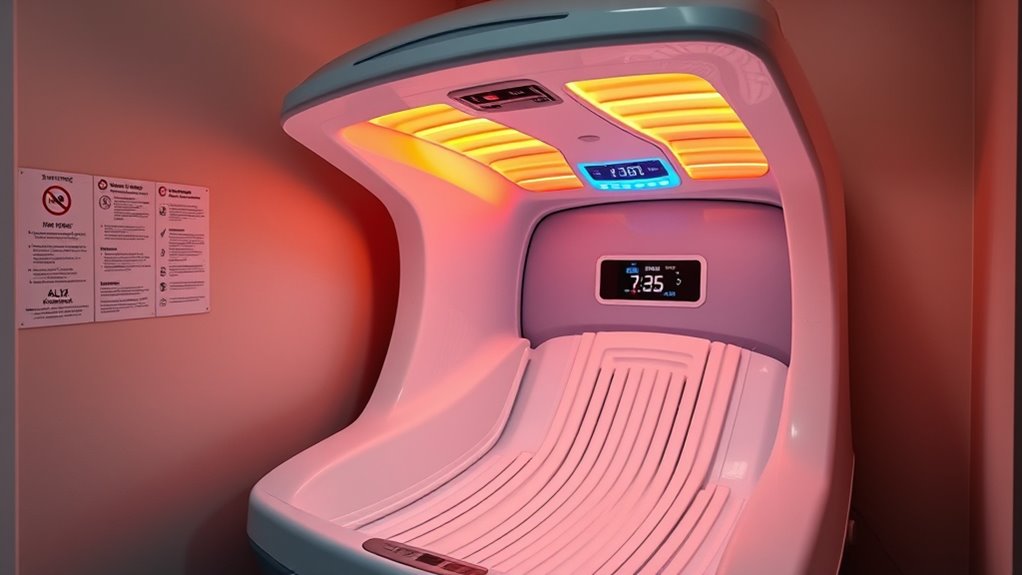
Are you aware of the legal requirements surrounding home tanning bed use? Many states restrict minors under 18 from tanning, with some requiring parental consent for ages 15-17, and Florida mandating parental presence and protective eyewear. You must review your local laws before installing a tanning bed at home. Federal regulations, overseen by the FDA, focus on safety standards like proper labeling, lamp specifications, and equipment safety, while the FTC monitors advertising claims. Operating a tanning bed commercially at home is often prohibited by zoning laws, and you may need permits or inspections if you plan to run a business. Enforcement varies locally, with penalties for violations, so staying compliant with age restrictions, safety standards, and consent requirements is essential to avoid legal issues. Additionally, understanding regulatory compliance is crucial for ensuring safe and legal use of tanning beds in a home setting. Being aware of state-specific laws can help prevent inadvertent violations and ensure responsible use.
Alternatives to Tanning Beds for Safe Tanning
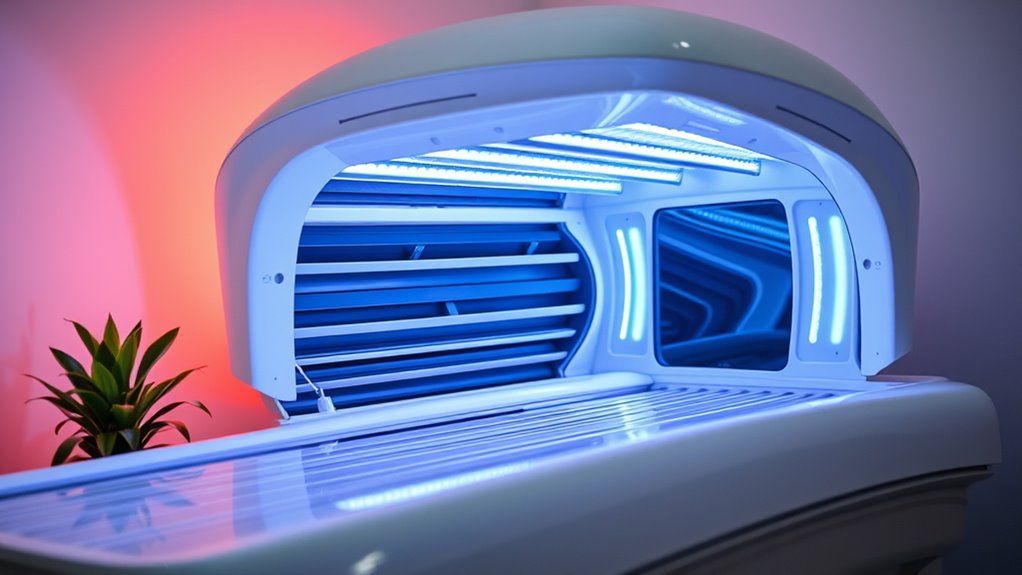
Instead of risking legal issues or health concerns associated with home tanning beds, exploring safer alternatives can help you achieve a bronzed look without UV exposure. Sunless self-tanning products, like lotions, sprays, and wipes, use FDA-approved dihydroxyacetone (DHA) to mimic a tan. They’re quick, customizable, and increasingly innovative, with many natural options avoiding harsh chemicals. Spray tanning booths offer professional, even coverage without UV, providing a darker, more uniform glow and reducing skin cancer risk—just remember to wear a mask during application. Topical bronzing lotions hydrate skin and develop a natural tan within hours, while tanning towelettes are convenient for travel and touch-ups. Natural, botanical-based self-tanners are gentle, non-toxic, and suitable for sensitive skin, giving you a safe, glowing alternative to tanning beds. Incorporating farmhouse kitchen textiles and accessories can inspire a cozy, natural aesthetic in your home. Additionally, understanding the risks of UV exposure can motivate safer tanning choices and promote skin health. Being aware of skin cancer prevention strategies can further encourage you to choose safer methods for achieving a healthy glow. Recognizing the benefits of herbal teas can also support your overall wellness and skin integrity while avoiding UV damage. Exploring natural skincare remedies can enhance your skin’s health and complement your safe tanning efforts.
Frequently Asked Questions
What Maintenance Is Required to Keep a Home Tanning Bed Safe?
To keep your home tanning bed safe, you need to perform regular maintenance. Sanitize it after each use, clean acrylic shields with approved disinfectants, and dry thoroughly. Replace lamps every 500-1000 hours, and check starters and electrical components routinely. Keep vents and filters clean to guarantee proper airflow. Also, inspect safety features like shocks and fans, and document all maintenance activities to prevent hazards and assure safe tanning sessions.
How Can I Ensure My Tanning Bed Complies With Local Regulations?
Think of your tanning bed as a trusted vessel that must sail smoothly through the legal waters. To guarantee compliance, first, know your local laws on age restrictions, registration, and safety requirements. Follow safety signage, maintain equipment properly, and use protective eyewear. Stay updated on any regulation changes, and document your adherence. Doing so keeps your tanning experience safe, legal, and worry-free, like a ship anchored in calm waters.
Are There Specific Accessories or Protective Gear Recommended for Home Use?
You should prioritize protective gear like high-quality goggles that fit comfortably and block all UV rays, preventing eye damage. Use disposable nose filters and hygienic covers for surfaces and your skin to reduce infection risk. Consider accessories like pillows for comfort, tanning progress charts, and ventilation fans for a better experience. Always keep your equipment clean and replace protective items regularly to guarantee safety and effectiveness during your home tanning sessions.
What Are the Signs of Skin or Eye Damage From Tanning Beds?
You should watch for signs like skin darkening within 48 hours, premature wrinkles, age spots, or leathery skin, indicating UV damage. If your skin becomes blistered, red, or burns easily, these are warning signs. For your eyes, notice redness, pain, light sensitivity, or blurred vision. Repeated exposure can cause lasting damage, so pay attention and seek medical advice if you notice any of these symptoms.
Can Using a Tanning Bed at Home Affect My Insurance Coverage?
Your insurance coverage might not be directly affected by using a tanning bed at home, but there are some risks to take into account. If you experience injuries like burns or property damage, your homeowner’s insurance could come into play, especially if claims are filed. Also, if you run a home-based tanning business, you’ll need specialized liability insurance. Keep in mind, health risks from UV exposure could influence your health or life insurance premiums.
Conclusion
While tanning beds might seem convenient, the risks often outweigh the benefits. If you think they’re a safe shortcut to that sun-kissed glow, remember that UV exposure can lead to skin damage and health issues. Instead, consider safer alternatives like self-tanners or spray tans—these options give you the glow you want without the harmful effects. Ultimately, protecting your skin now can save you trouble later—so choose wisely and stay safe.


